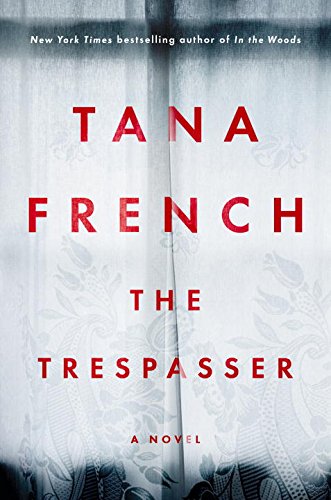Books |
Tana French: The Trespasser
By
Published: Oct 04, 2016
Category:
Fiction
GUEST BUTLER NORA LEVINE owns the literary mystery/thriller corner of this site. That’s my good fortune — I can’t read everything — and yours too. Nora introduced us — well, me, anyway — to Tana French and started many of you reading the Maisie Dobbs books. In her real life, she says, “I was a law librarian until it wasn’t so much fun. Now I edit my husband’s briefs (the legal type) in Oakland, California.”
Detective Antoinette Conway is back, and she’s still in a bad mood. (Her partner Stephen Moran is back as well, but it’s not really about him.)
This sixth addition to Tana French’s series, often described as “noir” whodunits, confirms again that Ms. French has carved a fine niche for herself. “The Trespasser” occupies familiar territory (Dublin neighborhoods and pubs) and involves familiar themes (an incident, a victim, a suspect or two, a theory, or two or three), but as with Ms. French’s other novels, I find that the story she wants to tell isn’t only about the crime.
And it is a compelling story. An anonymous call made to the precinct leads to the discovery of a young woman, Aislinn Murray, dead in her cottage, clearly interrupted in the midst of preparing a dinner party for two the night before. Her new-ish beau, Rory Fallon, for whom the table was set, becomes an immediate prime suspect. The Guards of the Murder Squad easily weave a time line of witnesses and behaviors and CCTV footage to implicate Rory, with some Guards having more reason to do so than others. As still relative newcomers to the Murder Squad, Detectives Conway and Moran quickly discover there isn’t much support from the Squad for alternative theories.
“‘If,’ I say. From now on, every time you say ‘if’ about this case, you owe me a quid. I’ll be rich by the weekend.”
Hidden within this seemingly formulaic “by the book” crime novel is a story about the hazards of being lead by assumption. Initially, Aislinn’s murder appears to look like the result of another relationship gone bad. Rory’s time line did not, in fact, match his statement, and Aislinn may not have been as interested in him as he thought. Assuming those “facts” would certainly and quickly solve a Saturday night lover’s quarrel and look good in the crime statistics. Yet an interview with Aislinn’s best friend Lucy adds an assumption that Aislinn might have been seeing another man. Can we assume married? Can we assume a gang member? What can we assume is in a password-protected folder on her computer?
“…Or else the folder’s full of naked selfies…”
“Or it’s photos of her with her secret fella….Blackmail. Or insurance. If she was with a gangster, maybe she had just enough sense to know this could turn dangerous.”
Conway realizes that she’s seen Aislinn before, and that recognition leads to more assumptions. Detective Breslin, the senior Guard sitting in on the investigation, has too many $50’s in his pocket. What’s to be assumed there? So many possibilities. Yet forcing the facts into one’s theories too often gets in the way of simpler truths. [To buy the paperback from Amazon, click here. For the Kindle edition, click here.]
A lot of reviews will focus on the grit of solving the murder – the legwork, the cynical detectives, the back and forth of the interrogations – and it’s a great ride. But this is also a story about identity and loss, and two women who have more in common than they will have the opportunity to realize. Aislinn’s father disappeared when she was a young girl; Detective Conway’s has never (yet) been in the picture. Each woman handled the absences differently, but both were or are defined by them. Aislinn was determined to find her “da.” Detective Conway was just as committed not to face hers. Different decisions, each of which came with a similar price.
“I was doing exactly the same thing as Aislinn: getting lost so deep inside the story in my head. I couldn’t see past its walls to the outside world. I feel those walls shift and start to waver, with a rumble that shakes my bones from the inside out. I feel my face naked to the ice-flavored air that pours through the cracks and keeps coming. A great shiver is building in my back.”
Conway may be considering the case at that moment, but she’s also considering much more; she just doesn’t realize it yet.
It’s hard not to read this novel in light of current turmoils between police and citizens: us-and-them, neither really seeing the other. It’s hard not to read these investigators as burnt out and their methods as hasty, prejudiced by experience, and cynical. But that would an incorrect assumption on the reader’s part. And we know where those can lead.


